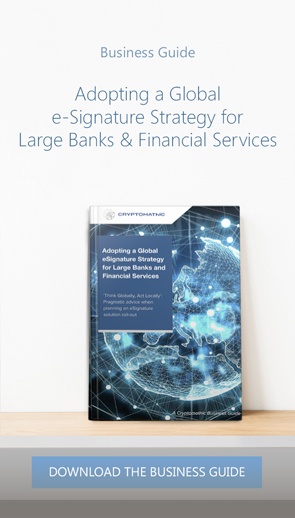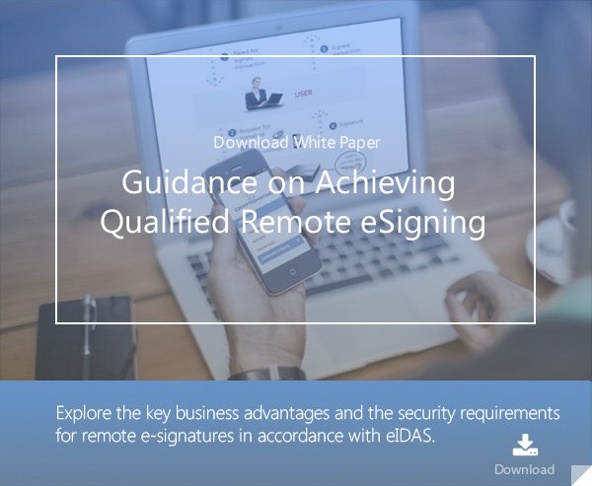2 min read
UK eIDAS & EU eIDAS: Implications for Cross-Border Transactions
Cryptomathic : 28. February 2022

- Home >
- UK eIDAS & EU eIDAS: Implications for Cross-Border Transactions
The eIDAS Regulation (No 910/2014) (EU eIDAS) came into force in 2016. It created a Europe-wide legal framework for electronic identification, transactions and signatures. How has this cross-border digitalization drive been impacted by Brexit for digital transactions between the EU & UK?
When the Brexit transition period ended, this basically meant that eIDAS, being an EU regulation, would no longer apply in the UK. However, the UK government has since incorporated the eIDAS rules into UK law (UK eIDAS) and modified some of the provisions via a Brexit statutory instrument (eIDAS SI).
What these modifications mean
This means that UK eIDAS has retained many important features of EU eIDAS, but has also introduced further modifications that impact the legal treatment of electronic signatures and other trust services.
These include:
- By allowing the technical standards and specifications in UK eIDAS to mirror those in EU eIDAS, UK eIDAS preserves mutual recognition of electronic signatures and other trust services. This means that e-signatures platforms (and trust service providers) based in the EU can continue to serve UK customers
- Only a 'qualified electronic signature' (QES) has the legal standing of a handwritten signature under EU eIDAS as it provides more security and a higher level of authentication than a standard electronic signature. The QES's elevated status is maintained by UK eIDAS. As a result, QES will play an important role in assisting organisations in managing some of the legal challenges associated with cross-border transactions between the UK and the EU.
- The UK-EU Trade and Cooperation Agreement 2020 (TCA) includes a guarantee that neither the UK nor the EU will discriminate against electronic signatures and electronic documents solely on the basis of their electronic format.
Other information of importance
 A UK party must always evaluate on a case-by-case basis whether an electronic signature will be recognised, and the document will be registrable and enforceable, in every jurisdiction relevant to the transaction for cross-border transactions with overseas parties. This requirement has not changed as a result of Brexit.
A UK party must always evaluate on a case-by-case basis whether an electronic signature will be recognised, and the document will be registrable and enforceable, in every jurisdiction relevant to the transaction for cross-border transactions with overseas parties. This requirement has not changed as a result of Brexit.
Customers need to be aware that In certain EU jurisdictions, there may be a legal requirement or a cultural preference for using digital signatures such as Advanced Electronic Signatures (AdES) and QES and again, these need to be considered individually.
Therefore, electronic trust service providers operating in the UK will need to comply with eIDAS rules under the UK eIDAS Regulations. However, UK trust service providers offering services in the EU (rather than in the UK) will still need to comply with the EU eIDAS regulation in EU member states.
UK law will continue to recognise EU-registered qualified trust service providers, which means that UK organisations can continue to use EU-based trust services.
The EU will cease to recognise UK-registered qualified trust service providers. This means that electronic signatures issued by those qualified trust service providers will not be treated as qualified electronic signatures under EU law. This may have consequences for the recognition of those electronic signatures and the validity of documents in EU member states.
To summarise
- If a QES (and other qualified trust services) is issued by a QTSP in any EU member state, it will still be recognised as a QES in the UK.
- A UK-registered QTSP’s qualified signatures (UK eIDAS) will not be recognized under EU law.
- For signatures that are accepted within the UK (for example, HM Land Registry as well as other Government requirements), UK eIDAS signatures will only be accepted. This includes electronic signatures, AdES and QES used to sign documents, including those used on eSigning platforms.
- For signing transactions that take place within the UK, for example, HM Land Registry as well as other Government requirements, UK eIDAS signatures will only be accepted. This includes electronic signatures, AdES and QES used to sign documents, including those used on eSigning platforms.
As a result, signature solutions need to be considered on a case-by-case basis, particularly when cross-border transactions take place. To make signing solutions applicable, solutions need to be provided that are recognized in the EU and in the UK.
